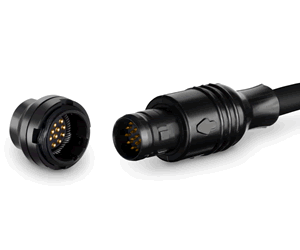Spring-Contact Technology in Circular Connectors
Today’s complex operating environments require connectors to offer higher density in a smaller footprint while being more rugged, robust, reliable, and lighter weight. Spring-enabled connector technology offers an array of options to conquer these obstacles.

Smiths Connectors’ SnapTac circular connector
Circular connectors are crucial to the successful performance of electrical devices across a variety of industries. These small, seemingly minor elements play an enormous role in the overall equation and are the technology at the heart of a system’s electrical execution. Circular connectors are paramount for ensuring and maintaining required signal integrity and reliable data transfer, which are often critical in application spaces within the medical, aerospace, and defense markets. They are also vital in industrial applications such as rail and oil and gas environments, as they must be able to perform in operating conditions that are often harsh in nature with extreme temperatures and severe shock, vibration, and corrosives.
A vexing problem confronting design engineers today is making the right choice when selecting the most appropriate circular connectors that will adequately support the power and data transfer functions associated with high-density applications across multiple industry disciplines. Today’s vast array of applications presents a diverse set of challenges for both design and test engineers. A trend driving the industry today is the requirement for much higher density, smaller pitches, and, as noted, reliable signal integrity. Across applications and industries the increasing requirements being levied upon connector technology have become broader and more demanding in scope in just the last few years alone. Today’s more complex climate requires connectors to accommodate higher density in a smaller footprint while being more rugged, robust, reliable, and lighter weight than historically possible. This has provided a daunting challenge for manufacturers to overcome.
Spring-enabled connector technology presents engineers with an array of options to conquer these obstacles. One such solution combines the high-reliability features of hyperboloid technology with the mechanical benefits of a spring-loaded contact, which results in a connector with excellent signal integrity, reliability, increased density capabilities, and proven parametric stability over time. This patented arrangement provides a compressible contact that ensures very low and stable contact resistance, high current-carrying capability, and extremely low-wear mechanisms; the design allows for extended operation over time to be realized within a sealed-while-unmated connector system. The spring-loaded mechanical feature within this hybrid technology is distinct from the hyperboloid portion, which optimizes the mechanical, electrical, and environmental performance of the connector.
Another option for consideration is spring-probe technology, which addresses a variety of unique demands and requirements via key advantages inherent in its design – comprised only of a spring, plunger, and barrel. A spring probe is compliant on the surface of its mating half, rather than extending into it as with traditional pin-and-socket connectors. This feature also helps to overcome tolerance misalignment of the target. They may be mated directly to a PCB, without back-end termination, to provide a very high degree of design flexibility with significant space savings. They are designed to engage and disengage at a 90-degree angle to the target contact, making them ideal for quick-disconnect application scenarios.
Spring probes are ideal for high-density applications with solutions for pitches as fine as 0.75mm. Contact length can be as short as 3mm to ensure low, stable contact resistance. Some spring-probe designs can accommodate up to 30A of current.
The world of design engineering is changing at a dizzying pace, impelling connector manufacturers to be agile and responsive in developing interconnect solutions that surpass the rapidly evolving requirements of the global customer community. Circular connectors featuring spring contact technology can be adapted to any shell geometry or material, be it circular or rectangular, plastic or metal. This flexibility, and the features intrinsic to spring-enabled contacts, make them an ideal solution to address the demands of a new generation of more discerning customers across the marketplace.
In the grand scheme of things, the term “circular connector” applies to any electrical connector that features multi-pin interconnects with cylindrical contact housings and circular contact interface geometries. Today, spring contact connectors stand at the top of the interconnect mountain principally due to the enormous design flexibility and high-density capabilities embodied within them. At the end of the day, their value provides customers a competitive edge through world-class technology performance.
Roberta Rebora is the vice president of marketing and communications with Smiths Connectors. Smiths Connectors is a part of the Smiths Interconnect division of London-based Smiths Group plc.




